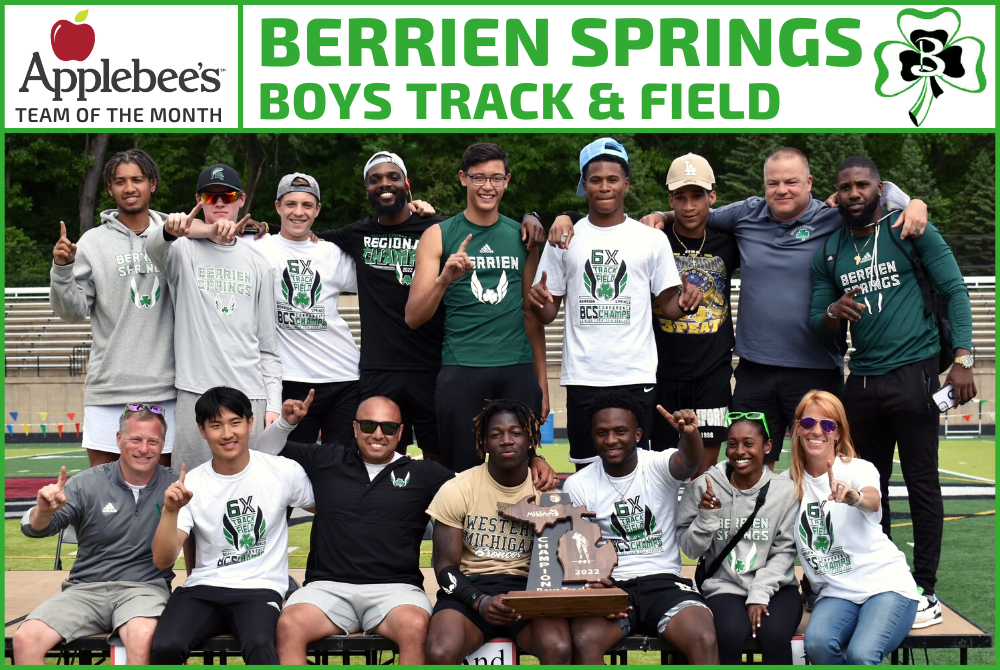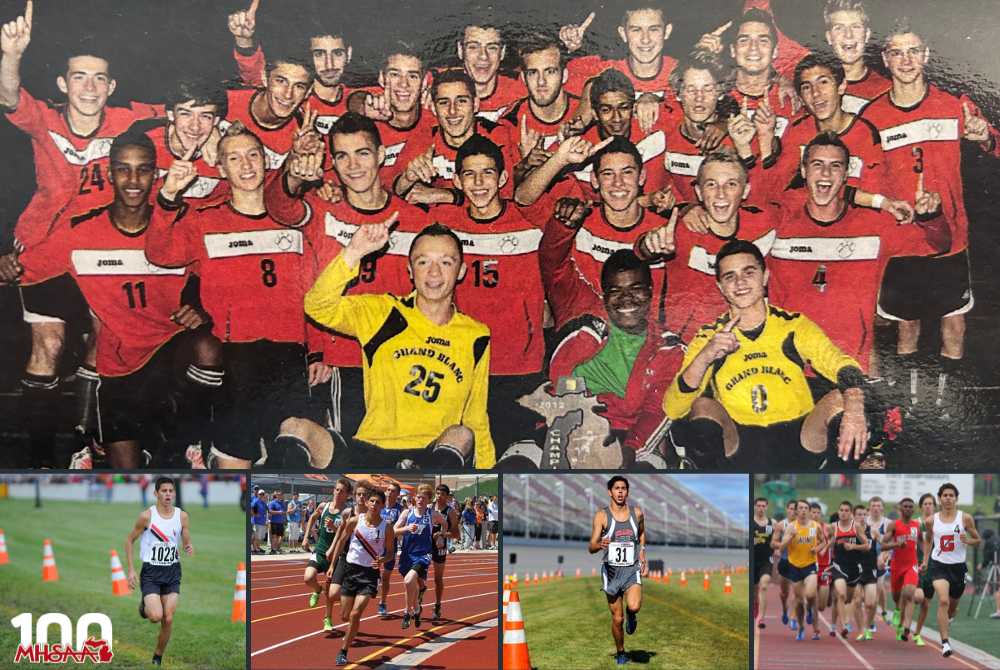
Team of the Month: Berrien Springs Boys Track & Field
By
Geoff Kimmerly
MHSAA.com senior editor
June 29, 2022
With two elite standouts comparable to the best pairs on any team statewide, and a deep group of sprinters capable of scoring major points, Berrien Springs track & field coach Johnathan Rodriguez had a feeling this could be a special spring for his boys team.
He scheduled tougher for that possibility, and planned everything pointing toward the Lower Peninsula Division 2 Final on June 4.
But Rodriguez didn’t breathe easily until that morning at Ada Forest Hills Eastern.
“I think the whole month, I think I was on pins and needles thinking of everything that could go wrong or wondering if we were ill-prepared or if we didn’t run them enough,” Rodriguez said. “And then we got to the meet that day, and they were just fresh and jumping around and happy, and we’re loose. They did very well.”
Berrien Springs – the MHSAA/Applebee’s “Team of the Month” for June – capped its season that day with its first MHSAA Finals boys track & field championship.
The title also was the first for the school in any sport since 2006, when the Shamrocks’ baseball team won the Division 3 title.
“We weren’t big on trying to win every meet. We were just thinking, all right, let’s try to be healthy for that state meet. So we were kind of smart in how we handled things and just scheduled things out so we can peek at the right moment,” Rodriquez said. “And I think it’s kind of a gamble that made us all uneasy, but they were just on fire that day.”
The boys track & field team had finished LP Division 3 runner-up in 2018, its highest Finals finish since coming in second in 1953. But with enrollment lines driving downward the last many years, Berrien Springs found itself it a much different spot beginning in 2021. The Shamrocks went from one of the largest schools in Division 3 to one of the smallest – the 11th-smallest of 155 teams this season – in Division 2.
Still, Berrien Springs received a strong indication it could compete with anybody this season when it ran at an invitational April 29 in Warsaw, Ind., against a number of larger Indiana schools include state power Carmel. Senior Jamal Hailey won the 100 and 200 meters, the 400 relay finished second, and senior James York was third in high jump as the Shamrocks hung with competition similar to the best they’d see in Michigan this spring.
Berrien Springs also possessed the right strengths to succeed in a championship format. The Shamrocks won their Regional by 37.5 points May 20 in part because the sprint group took nine top-eight places in the 100, 200 and 400 and won the 400 and 800 relays. The same formula worked as they won the Berrien-Cass-St. Joseph Conference championship meet the next week.
At the Finals at Forest Hills Eastern, Hailey won the 100 (10.77) and 200 (22.11) and York won the long jump (22-10). The 400 relay of senior Junyoung Chung, York, sophomore Jake Machiniak and Bailey won the 400 relay (42-44), and senior CJ Porter, Young, freshman Zander White and York placed eighth in the 800 relay (1:31.11). Freshman Noah Jarvis just missed scoring with a ninth place in the 400 (50.99).
With points spread out across several contenders, Berrien Springs’ 41 won the meet by eight.
Hailey finished the season undefeated in the 200 and with only one non-win in the 100, a runner-up finish at an early-season invitational. The 400 relay also was undefeated except for that second place in Indiana. York was undefeated in long jump except for finishing second in the Regional and league before coming back to win at the Finals. The 400 relay won every time he was a part.
Berrien Springs has had some recent success in other sports, particularly with Hailey leading a football team that went 10-1 last fall. This spring’s championship could be a catalyst for more Finals-level success in the near future across other sports.
“I hope so. I think that every kid that we had qualify (for the Finals) was a multi-sport athlete kid, and I think our 4x1(00) team, everybody on there was a three-sport athlete guy,” Rodriguez said. “Our athletic department works well, like our football guys lift with football two days a week and then come after track practice, so we have that nice working partnership with all the athletes.
“Now that we’ve shown that we can get there, I think it’s (shown) the kids at our school that hey, we can beat the bigger schools. We can hang. Track did it. Maybe we can do it next.”
Past Teams of the Month, 2021-22
May: Houghton boys golf - Read
April: Plainwell girls soccer - Read
March: West Bloomfield girls basketball - Read
February: Cadillac girls skiing - Read
January: Hartland hockey - Read
December: Midland Dow girls basketball - Read
November: Reese girls volleyball - Read
October: Birmingham Groves boys tennis - Read

Flashback 100: Fisher Races to Finals Stardom on Way to U.S. Olympic First
October 11, 2024
No American had ever won medals in both the 5,000 and 10,000-meter events at an Olympic Games until Grand Blanc’s Grant Fisher did so in Paris this summer.
He claimed bronze in both races, finishing just two-hundredths of a second behind second place in the 10,000. Fisher secured his opportunities in Paris by finishing first in both events at the U.S. Olympic Trials in Eugene, Oregon.
During his time at Grand Blanc, Fisher won two Lower Peninsula Finals championships in cross country, taking first place in Division 1 in both 2013 and 2014, his junior and senior years, respectively. In Track & Field, he earned five MHSAA titles, including winning the 3,200 meters in 2013 and both the 1,600 and 3,200 meters in 2014 and 2015.
As a sophomore, Fisher played on the Grand Blanc soccer team that advanced to the Division 1 Final, ultimately losing to East Kentwood 1-0. He played for coach Greg Kehler, who retired from coaching boys soccer after the 2020 season with 340 wins, ninth most in MHSAA history. Kehler is the current girls coach at Grand Blanc and is fourth all-time with 402 victories.
Currently, Fisher holds the American records in the 3,000 meters, two-mile, 5,000 meters and 10,000 meters. In 2015, he became the seventh American high school student-athlete to run a mile in under four minutes and holds the MHSAA Lower Peninsula Finals record (all divisions) in the 1,600 meters at 4:00.28. At Stanford, Fisher was a 12-time Track & Field All-American and three-time Pac-12 champion.
Previous "Flashback 100" Features
Oct. 4: Lalas Leaves High School Legacies on Ice & Pitch - Read
Sept. 27: Tamer's History-Making Run Starts in Dexter, Continues to Paris - Read
Sept. 20: Todd Martin’s Road to Greatness Starts at East Lansing - Read
Sept. 13: James Earl Jones, Dickson High Hoops to Hollywood Legend - Read
Sept. 6: Pioneers' Unstoppable Streak Stretches 9 Seasons - Read
Aug. 30: Detroit dePorres Rushes to 1995 Class CC Football Championship - Read
PHOTOS (Top) Grant Fisher (15) takes a photo with his Grand Blanc soccer teammates as a sophomore. (Bottom) Fisher competes in multiple Cross Country and Track & Field Finals during his high school career. (Soccer photo courtesy of Greg Kehler. Running photos by RunMichigan.com.)

